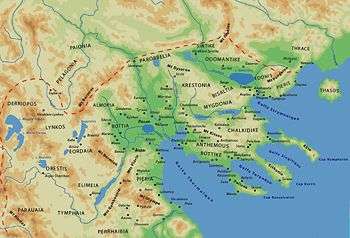Chalkidian League
The Chalkidian League (Greek: Κοινόν τῶν Χαλκιδέων, "Koinon of the Chalkideans" or Olynthians[1] or Χαλκιδεῖς ἐπί Θρᾴκης[2] Chalcidians in Thrace to distinguish them from Chalcidians in Euboea)[3] was a federal state that existed on the shores of the north west Aegean from around 430 BCE until it was destroyed by Philip II of Macedon in 348 BCE.[4]
History

In 432 BCE Olynthos broke away from Athens. Along with several other cities, some form of united state was formed with Olynthos. Exactly what form it took is a matter of academic dispute.[5] By the terms of the Peace of Nicias of 421 BCE, Athens and Sparta agreed that it should be broken up but it seems clear that Athens failed to enforce this.[5] However, because the Chalkidike was no longer the arena of conflict between Athens and Sparta, nothing is heard of it from that time until 393 BCE.
In 393, Amyntas III of Macedon temporarily transferred some territory to Olynthos during a period when he was driven out of Macedon by Illyrians. It was restored when Amyntas regained power. Eight years later, Amyntas again in trouble handed over territory, this time to the league. The League were not so ready to return what they held which now included Pella the capital of Macedonia.[6] In 383 BCE, Amyntas appealed to Sparta and at the same time a similar appeal came from Akanthos and Apollonia, two League members who claimed that that membership of the League was not voluntary but enforced at the point of a sword.[7] Sparta was keen to respond to the request. Amongst Sparta's allies there was no animosity against the Chalkidian League. Nevertheless, when the question was put, fear of annoying Sparta ensured that the proposal was carried. A force of 10,000 was authorized to be sent.[8] An advance force of 2,000 was sent under Eudamidas which succeeded in separating Potidaea from the League.[9]
The fighting was long and arduous.[10] Teleutias, the half brother of the Spartan king, Agesilaos (or Agesilaus II), was killed and King Agesipolis suffered heavy losses before dying of fever.[11] However, in 379 BCE the cities of the former League became "autonomous" and subject allies of Sparta.[12] Freeman regards the Spartan dissolution of the League as one of the most "calamitous events" in Hellenic history for, in his view, the League uniting the northern Greek cities with the most hellenised cities of Macedonia would have prevented the rise of Philip II of Macedon,[13] who later destroyed the Chalkidian League.
Internal Organization
The actual form of the League is uncertain. It seems it was a genuinely federal state with common laws and coinage and was probably based on the Boeotian League. Political rights are likely to have been reserved to a group of 8000 designated by a property qualification.[14] It included most but not all the Euboean colonies of Chalcidice. The symbol of the Chalcidians was the lyre, struck upon the coins the League.
See also
Notes
- ↑ In Greek and Roman historiography, during this period, Olynthians refers mainly to the League, rather the citizens of Olynthus (see Justin 7.4.6)
- ↑ IG II² 36
- ↑ Chalcis-in-Euboea, iron and Chalcidians abroad By S. C. Bakhuizen, R. Kreulen Page 14 ISBN 90-04-04546-5 (1976)
- ↑ Philip’s Destruction of Olynthus
- 1 2 Agesilaos , P Cartledge p268
- ↑ Agesilaos , P Cartledge p. 269
- ↑ Historians History of the World, Editor: Henry Smith Williams vol 4 pp129-30
- ↑ HISTORY OF GREECE, G Grote, 1862 vol9 p49
- ↑ Xenophon, Hellenica 5.2
- ↑ Agesilaos , P Cartledge p271
- ↑ Agesilaos , P Cartledge p373-4
- ↑ Agesilaos , P Cartledge p272
- ↑ History of federal government, Edward Augustus Freeman, p. 191
- ↑ Agesilaos , P Cartledge p269
Coordinates: 40°30′N 23°12′E / 40.5°N 23.2°E